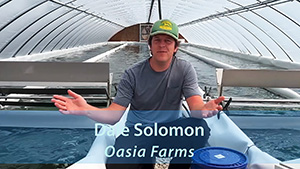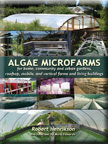Dale Solomon
Founder & CEO • Oasia Farms
video recorded July 1, 2023
Summary: Dale Solomon is an algae entrepreneur in California. After six months of research on growing spirulina and learning about the market, he started Oasia Farms, a greenhouse microfarm in 2017. Dale opened his second spirulina farm in Nipomo near the Central California Coast. Began construction in 2022. Even during the rainiest winter in years, by February 2023, growing ponds were installed and spirulina cultures expanded. By June, Oasia Farms was in full production with two greenhouses. Dale shows the ponds and greenhouses and documents the harvesting and processing. Oasia Farms sells fresh and frozen spirulina direct to customers and online and sells fresh spirulina to other marketing companies.
Narrator- Robert Henrikson:
Oasia Farms in Nipmo, near the Central California coast, is Dale Solomon’s second spirulina farm. Visiting in October 2022, the hoop greenhouses are already erected. Even during the rainiest winter in years, by February, growing ponds are installed and spirulina cultures expanded. By June, ponds in both greenhouses are growing healthy spirulina. Oasia Farms is in full production.
Dale Solomon:
Hi – My name is Dale and this is Oasia Farms.
What you are looking at right behind me here are ponds 5 and 6. These are our small production ponds and they are each about 50 square meters, so 100 square meters total. They are 100 feet by 24 feet, they take up the full width of this greenhouse. We are getting a decent amount from these. About 100 to 150 pounds a week in the good part of the season.
Robert Henrikson:
Tell us about this production pond here, it’s a big one.
Dale Solomon:
This is a very large pond. This is our biggest production pond, called P7. this was designed to be very modular. It was easy to construct and we are getting a lot of capacity, this is a 400 square meter pond.
So the goal is to continue building this model, this design, again and again for easy expansion. As you can see it’s just massive, taking up the entire greenhouse, 24 by 200 feet.
This 200 foot one, we’d like to continue to build out these as sort of a standard model for production. This one is the one we want to roll with.
Robert Henrikson:
You’ve got 400 square meters of pond area.
Dale Solomon:
Correct. Just wall-to-wall. We used corrugated steel to make the sidewalls. Then we used insulated them with foam. It’s just an affordable, simple, easy-to-run system that’s modular.
Robert Henrikson:
You’ve built a large evaporation pond.
Dale Solomon:
We have some waterways here. If we start dumping nitrates in the ground,it is really going to create environmental problems, so I said it’s gotta be big, we’ve really got to oversize this thing. That’s why we built that so large. We will probably have to build a second one eventually and switch between the two, letting one dry out and scoop everything out of it, while we fill the second one, back and forth. For now, for the next year or two, this one will be just fine.
Dale Solomon:
Harvest Sequence
Ok, we’re here at Oasia Farms with Miguel.
We’re harvesting pond 7 today. This is how we start off the harvest. The pump will bring the water with spirulina up and over into this 300 micron filter. That’s filtering out any debris, little plant matter, or something that might have flown into the ponds.
And then it goes over here on this 37 micron harvest screen, which is small enough that it actually catches individual filaments of spirulina. The water is dropping back down, and you can see down below here just water and nutrients in it.
This is what the biomass looks like before it’s been pressed. About 7% to 10% solids. there is still a lot of water outside the cells. We need to remove that.
We put that inside a smaller harvest screen, then take it over to the press.Put it inside that press, and we squish all the remaining water out of it.
400 pounds of weight forcing down right there, because of the leverage of this arm. And we end up with a really nice, dry spirulina cake. It really has almost no flavor.
This gets brought into the fridge where it cools down. Then is a couple of hours we’ll package that up.
Dale Solomon:
We would like to continue moving eastward here and fill up this field. As you can see there are 10 acres of strawberry fields and we would like to continue building greenhouses in that field.
Dale Solomon • Oasia Farms • www.oasiafarms.com • dale@oasiafarms.com





